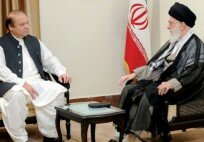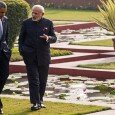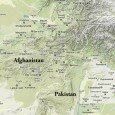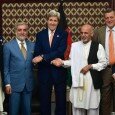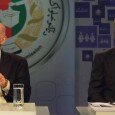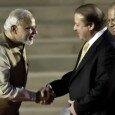Deepak Adhikari :
Ahmadi Pakistanis escaped to Nepal to save their lives from persecution but found themselves dogged by economic troubles
On a recent Sunday afternoon, a voice in Urdu echoes through a desolate neighborhood of a valley on the outskirts of Kathmandu. We are climbing a four-story building tucked away against green paddy fields. The voice grows louder. At the cramped, top floor apartment, amid a tattered carpet and mattresses, a desktop computer sits beside a rickety table fan. It is playing a grainy video for perhaps the umpteenth time. The video shows a heated debate between an analyst and a television presenter. A Pakistani family is huddled around the computer and watching The Lucman Show at News 1 Channel. Broadcast originally in 2007, it shows Mubshar Lucman grilling guests about Ahmadiyya community and its history in Pakistan. Downloaded from YouTube, the video shows a picture of mustachioed Gen. Zia-ul-Haq in the background.
This neighborhood is a far cry from the family’s ancestral village in Narowal district in the sun-blasted plains of Punjab.
But Naveed Ahmad, 35, a slender, gregarious man, is forced to call it home. He is among countless other Ahmadis, declared non-Muslims according to the 1973 constitution of Pakistan, who have fled their homeland and sought refuge across the world: in the United Kingdom, in Sri Lanka, Bangladesh, Indonesia; among others. “I have wasted my youth. I have been here for nearly 10 years. And, there’s nothing. Neither can we go back to our country nor this country accepts us as citizens,” Naveed said when I visited him.
According to Naveed, his troubles began in mid-March 2004.
Much to the chagrin of the locals, the extremist group Lashkar-e-Jhangvi built a Madrassa about 150 metres away from his home. Soon rumours spread that the madrassa was used to train the Jehadists. One day, Ghulam Rabani Jhangvi, the Maulana of the madrassa called a meeting with the villagers. “He told the village folk that his life was under threat, without specifying who threatened him,” Naveed recalled.
Among more than 300 families in the village, Naveed’s was the only Ahmadi family—which made it easier for their adversaries to single them out. His father, Chaudhry Majeed Ahmad, who ran a carpet factory which employed 50 artisans, left home with his uncles to attend the meeting. Later, his family would realize that the “Maulana was not only stoking fears but he was also telling a blatant lie,” he said. Nevertheless, his statement precipitated a sharp division among the villagers. The 1000 or so villagers were divided between the supporters of Jhangvi and his opponents. It also divided them between those who wanted to shut down the Madrassa and those who wanted it to remain open. “Then, the supporters of the Maulana spread rumours, saying that Ahmadis were trying to shut the Madrassa. They accused us that our headquarters in London had sent money to lobby for the closure,” Naveed said.
The stand-off continued for a month. Although the supporters of Maulana were in majority, the madrassa was shut down. But maulana’s supporters were attempting to re-open it. Some of the villagers came looking for his father’s advice. “He said it should remain closed because it was acting as training grounds for terrorists,” Naveed said. Then in mid-April 2004, a group of armed young men arrived in their village (to forcibly open the madrassa). Nearly 500 people including women and children gathered in opposition. Both groups had arms and were about 200 meters apart. As tensions ran high, each side waited for the other to blink.
In order to break the deadlock, his father suggested that one of the members from the Ahmedis’ side fire blank shots near the madrassa. Then, he went to make a call to the district police head. He calculated that the arrival of policemen would diffuse the situation.
Dozens of policemen, including Special Elite Force commandoes, in several trucks were dispatched. After they arrived, the agitated groups slowly dispersed. The policemen locked the madrassa with their own locks. It remains shut till today.
But if Naveed thought the confrontation was an end to the bitter battle in his homeland, he was completely wrong.
Less than six months later, he was caught in a revenge attack that left him with no other option but to flee his home. One afternoon in September that year, a group of half a dozen young men stormed into his family owned wheat fields and destroyed the crops. After hearing about it, an enraged Naveed rushed to the scene only to witness its ugly aftermath. “They had destroyed everything,” he recalled.
A brawl followed in which some villagers attacked the invaders with batons. At around 7:30 p.m. that day, the young men returned with AK-47s. One of them shot Naveed on his foot. He was rushed in a tractor to a hospital some 10 kilometers away from the village. But even before he could convalesce, an FIR was filed against him in local police station. As a result, he had to spend two months in jail.
As Naveed languished in jail, his family planned his escape. His father applied for his passport. Naveed signed the documents from behind bars. And after he was released following a bail of Rs. 80,000, he weighed his ever dwindling options: Where shall he go?
Three Ahmadis in a nearby village—two young men and a middle-aged man—were murdered back in those days, raising fears for his and his family’s safety. “My family said situation had significantly worsened. So, leaving the country was the only way-out,” he said.
Naveed considered potential destinations, without knowing much about the countries: Sri Lanka, China, Hong Kong and so forth. He zeroed in on Nepal “because it didn’t charge for the visa,” he said.
In November, Naveed left Lahore for Karachi. From Karachi, he paid Rs. 17,000 for an air ticket in a Pakistani International Airlines flight to Kathmandu. All he had was US $ 600, hardly sufficient for such a perilous journey.
Soon, problems began to surface. He was not allowed to board his flight because the authorities were skeptical of his account that he was a tourist traveling to Nepal. “Ahmadis are fleeing the country. They are tarnishing our image,” a policeman told him at the Karachi airport. He lingered in Karachi for a week and finally decided to pay bribe for his exit. “I tried to bribe 100 dollars but the airport official declined it”, he recalled.
The close circuit cameras posed yet another hurdle as the official was cautious not be caught by it. Naveed found a way out: he tucked three hundred dollar bills inside his passport. The official in the ruse of checking his passport, glided the bills into his drawer.
On November 27, 2004, Naveed landed in Kathmandu, it was drizzling and he had only the haziest notions of the country. Neither did he understand Nepali language nor did he know a single soul in the city. He had never been to any other foreign country except India. But the smattering of Hindi he knew came in handy. At Kathmandu’s chaotic airport, he was ushered into a taxi, the driver promising him a meeting with a fellow Pakistani. Before long, he shared rooms with two Pakistani refugees. A month later, he was registered at UNHCR as an urban refugee. Three years later, his wife and four brothers joined him. “I got married in Nepal and my sons were born here,” he told me, explaining that his family— the 70-year-old father and 65-year-old mother—had chosen his cousin as his wife in 2006.
Nepal government doesn’t recognize the Pakistanis as refugees. Nepal is not signatory to the 1951 Refugee convention and hence it is not mandatory for the country to accept refugees apart from Bhutanese and Tibetans, who are granted asylum within its borders. But under the UNHCR protection plan, the Pakistanis received a measly monthly allowance of 5,000 Nepali rupees and free education and health care. Naveed says it is not enough to run his family of eight. The Nepal government often launches a crackdown on what it calls ‘illegal immigrants.’ Nepal government’s strict measure hasn’t stopped more Ahmadis from making their trip to this land.
In November 2008, the immigration authorities raided his room in Mandikhatar on the outskirts of Kathmandu and arrested his three brothers. Navaeed was a few kilometers away in a government run hospital for his son’s treatment when he heard about the arrests. The security officers asked for his brothers’ passports. Naturally, they had been expired. The youngest of the brothers was barely 17, so he was released. But the two—Waheed (now 31) and Saeed (now 26) were jailed for six months. The UNHCR filed a writ at the Supreme Court which ruled in 2009 that the duo were refugees, paving the way for their release and some degree of relief. Now, Nepal is home to around 135 Ahmadis. But Naveed says the actual figures might be more than 400.
Zulfiqar Ali Goraya, 40, arrived in Kathmandu on May 20 this year. But his visa has expired and the UNHCR has not provided him with a refugee ID. “I called them a month ago. They told me it is under process and told me I will get it soon. But I don’t know when,” Goraya, a rotund man wearing a colourful T-shirt, told me on a recent afternoon.
As a salesman of spices and salt packets making rounds of small towns across Sindh, Goraya started to face discrimination after his customers learned about his faith.
“I used to drive on a motorbike, supplying my wires. But after people came to know about my faith, they refused to do business with me,” he said. A native of Kunri in Sindh province, he moved to Hyderabad in 2011 to avoid the discrimination. Before long, he found out that he was not welcome even there. Then in January this year, he started to work in Khuda-ki-basti, a town in Kotri district.
On the evening of January 14, he was driving his bike when a jeep blocked his way. A group of seven armed men waylaid him and bundled into the jeep. He was driven half an hour through an unpaved road. “They tied my hands and legs and started to beat me and threatened me to kill if I didn’t declare myself a Muslim,” he recalled. Since the attackers believed Ahmadis were not Muslims. As a result of such assaults Goaraya felt somewhat threatened to pack up and leave.
Goraya remembers that as dusk fell, the armed men argued over whether to kill him or not. “One of them suggested that if they shot me dead, people will hear the gunshots and it could create trouble. So, they decided to leave me there so that wild animals will devour me,” he said.
The following morning, a shepherd saw and rescued him, giving him a new lease of life. He gained consciousness only at 11 in the morning. The shepherd applied medicines to his wounds and arranged for ox cart driver to lift him to his home some 25 kilometers away.
“My wife and family members started to cry and suggested me to stop the work. I also tried to find work in Karachi but didn’t have luck and stayed at home,” he said. Every thing became unbearable when his wife who, as per Ahmadi custom, dressed in head-to-toe Burka, was en route to pick her son from school, was one day abused by some locals. “They pulled her Burka from behind her. Some people even urged them to attack her with rocks,” he said.
Leaving an unwelcoming society was the only option.
Now Goraya lives with his 28-year-old wife Atiqa Aziz and two sons aged 7 and 5, a 10 minutes walk from Naveed’s apartment.
Naveed’s sister Maunazza Tabasum, 36, who arrived with her husband on June 4, 2006, has even a more sorrowful story to tell. Her husband Ataul Rehman, 45, who was suffering from paralysis and depression for nearly a decade, died in a Kathmandu hospital on March 14 this year. She says he would have survived, had he been admitted to a better, private hospital. “He had a chest infection and the fever was 106 degrees. It should have been cured but he died after being admitted for five days,” she said. She can not leave Nepal because the government would not allow her until she paid 1.4 million Nepali rupees as exit fee for her ‘illegal stay.’
She spent 60,000 Nepali rupees for the delivery of her husband’s dead body because Nepal wouldn’t allow its burial in Kathmandu. Life appears bleak.
Naveed, the Ahmadi from Narowal district, is also distraught, driven by a life that is uprooted and torn apart by economic hardships.
“It’s so difficult to live this way. We want a permanent solution. We want to be free from this cage,” Naveed said with a heavy, almost choking voice. “A film finishes in two to three hours but our movie has continued for 10 years. And, there’s no sign of it ending.”
Deepak Adhikari is a journalist based in Kathmandu. He has written for The Caravan magazine, Himal Southasian magazine, Time magazine, among others. He tweets @DeepakAdk





























































